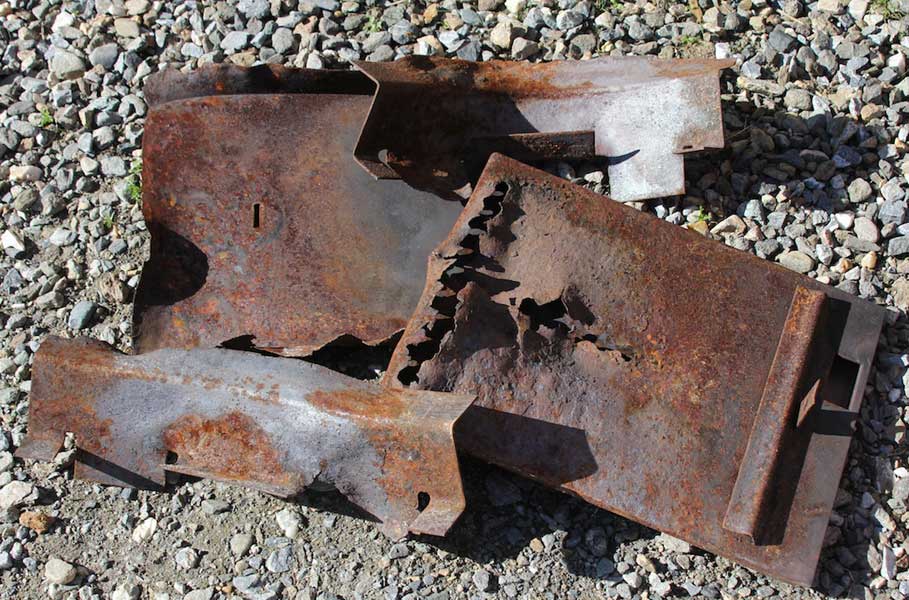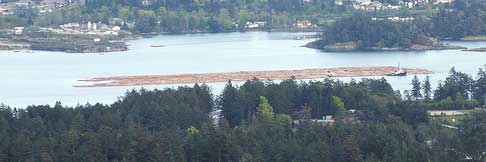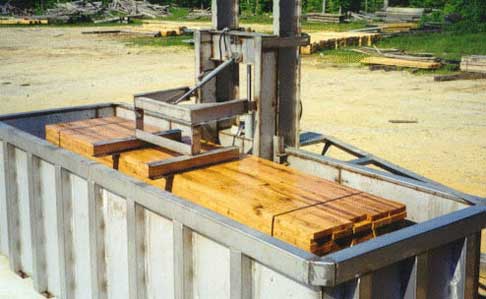Q:
My name is Glen Smith and I am a Fire Fighter/Fire Inspector.
A homeowner approached me today asking about burning kiln dried 2x4
scraps in his wood stove. He had been talking to someone at a local fireplace store who told
him that burning dimensional lumber would void
the warranty of their stove and metal chimney. They were also told that their insurance would not cover them if a chimney corroded out and caused
a fire. As part of my research I came across other sources stating that mill ends give off chemicals that harm the stove and metal chimney.
Hopefully you can answer a few questions for me so I can be assured that I am passing on accurate info;
I am wondering what chemicals are released, and how they differ between kiln dried 2x4 scraps and seasoned firewood?
If you have any links to sites that have some scientific data in relation to this issue?
Do you have any manufacturers that specifically talk about this, as I have found no one who states this in either their installation or warranty data?
I do understand that we do not want to burn plywood, mdf, chip board, pressure treated, or painted lumber in stoves due to the chemicals in them.
As you can probably understand, when given this info the homeowner was extremely concerned. The fireplace shop even went so far as to show
him a section of chimney that was supposedly corroded out after only 6 months of burning dimensional lumber scraps.
I am not one for hype and I do not want to have people exposing themselves to risks if they truly exist, its just that the investigator in me needs to
have some solid evidence before I make a comment either way. I thank you for any assistance that you can provide in this issue.
Glen Smith
 You're right; very little has been written about burning dimensional lumber (mill ends and pallet wood), and we know of no official study
or laboratory testing that has been performed on the subject. Our opinion about burning dimensional lumber originally derived from repeated
experiences by our customers with premature stove and chimney damage over the years, where burning mill ends or wood from broken-down
pallets was the only common denominator. The extent of this damage ranged from "shaling" (where flakes of metal peel off internal stove
components) to extreme warping, and even big holes eaten right through heavy steel baffle plates and stainless chimney liners. At first, we had no
idea why dimensional lumber would cause this problem, but over time we've come to believe that the issue with burning mill ends and pallet wood
has to do with the combination of the
higher temperatures achieved in today's EPA-approved woodstoves and some of the
chemicals even
"untreated" dimensional lumber might contain. You're right; very little has been written about burning dimensional lumber (mill ends and pallet wood), and we know of no official study
or laboratory testing that has been performed on the subject. Our opinion about burning dimensional lumber originally derived from repeated
experiences by our customers with premature stove and chimney damage over the years, where burning mill ends or wood from broken-down
pallets was the only common denominator. The extent of this damage ranged from "shaling" (where flakes of metal peel off internal stove
components) to extreme warping, and even big holes eaten right through heavy steel baffle plates and stainless chimney liners. At first, we had no
idea why dimensional lumber would cause this problem, but over time we've come to believe that the issue with burning mill ends and pallet wood
has to do with the combination of the
higher temperatures achieved in today's EPA-approved woodstoves and some of the
chemicals even
"untreated" dimensional lumber might contain.
Wood exhaust is acidic, containing carboxylic acids and phenols which eat slowly but steadily away at stoves, stovepipes and chimneys. When a
component is said to have"burned out," what has actually happened is that the acids in the wood exhaust have finally eaten through.
When
additional chemicals are added to the natural acids in the wood exhaust, the rate of corrosion can increase exponentially.
Regardless of its origin, all dimensional lumber has been transported from the forest, has been through a sawmill, and has been dried in a kiln.
Each
step in the process has the potential of introducing corrosive chemicals to the wood fiber.
Wood has a bundle-of-straws structure that delivers
water and nutrients from the roots to each leaf on the tree. After a tree is cut down, that same structure causes any liquid that comes in contact
with the endgrain to be soaked up via capillary action (this is why fuelwood must be stacked out of the rain to season properly). This sponge-like
property of wood causes it to soak up not just water, but also any chemicals in solution it might encounter.
Here in the Pacific Northwest and in other coastal areas, one of those chemicals is
salt. Salt is tremendously corrosive to metal and masonry
materials, and this corrosive effect is multiplied at high temperatures (it is a well-known fact that people who burn salt-water driftwood in their
woodstoves, for example, soon see the result in the form of corroded-out stove components, stovepipe and chimneys).

Stainless Steel Baffle and Side Rails after burning saltwater driftwood for four seasons
As it happens, dimensional lumber may also contain salt. In coastal areas, the most economical way to transport logs is via log boom: the logs are
floated in the ocean, harnessed in a big loop made of chained-together logs, and towed by tugboat to the mills.

A log boom, on its way to a BC lumber mill
Immersion in salt water results not only in a coating of salt on each log, but also in absorption of dissolved salt crystals deep into the wood fiber.
Ocean transport isn't the only way salt can find its way into wood: after delivery to the sawmill, logs must be kept wet to prevent end-cracking due
to the natural drying process, which is sometimes achieved by storing them in
log ponds. Introduction of salt-infused logs to a sawmill's log ponds
contaminates the ponds, exposing even loads that were trucked in straight from the forest to salt infusion. This phenomenon isn't strictly limited to
coastal areas: when economics dictate, salt-infiltrated logs often make their way to lumber mills far inland, via rail and truck transport.
The trip through the sawmill can also introduce chemicals to the wood. To combat "blade binding" and keep the sawblades sharp, sawmill operators
must constantly keep the blades coated with
liquid lubricant, using a sporadic spray-on or continuous drip method to keep the sawblade coated
while the wood is being cut. A variety of chemicals are commonly used as sawblade lubricant, including
diesel oil, antifreeze, paint thinner and
kerosene. Trace amounts of these chemicals can be found on all surfaces of each piece of lumber that has been through the saw. Combustion of
these substances produces a variety of corrosives, including
sulphuric acid.
Another chemical that might find its way into dimensional lumber is
polyethylene glycol (PEG-1000). In recent years, a process known as "dry kilning"
has become the industry standard for drying lumber, as it enables much faster removal of the natural liquids contained in the tree. Dry kilning
allows much more efficient processing of dimensional lumber, but it can cause excessive shrinkage and cracking of the wood: to prevent this, the
green logs are soaked in a solution of PEG-1000, which infiltrates deep into the wood fiber and "bulks" the wood so it won't shrink or crack in the
kilns. PEG-1000 is sometimes used even in old-fashioned mills where dry kilning hasn't yet been implemented, because after kilning, trace amounts
of PEG-1000 migrate to the surface of the lumber, creating a "waxy" coating on each piece which inhibits oxidation and natural enzyme
breakdown of the wood fiber. This waxy coating actually provided one of our first tip-offs to the emerging use of PEG-1000 several years ago,
when a long-time employee at our local lumber yard complained that he had recently learned he must be extra-careful moving stacks of lumber
with his forklift, because if he stopped too suddenly, the then-new "slippery" lumber would slide right off the forks. Thermal decomposition of
PEG-1000 produces aldehydes in extreme concentrations, which combine with the
natural aldehydes and water found in wood exhaust to create a
corrosive acid bath inside the stove, stovepipe and chimney.
For various reasons, including the waxy surface situation, furniture-grade lumber is not typically soaked in PEG-1000. But that doesn't mean the
leftovers from your local cabinet shop are chemical-free. Once out of the kiln, lumber is stacked in bunches separated by wood slats called
"stickers". Over time, these stickers can cause discoloration of the wood, resulting in off-color stripes across the grain known in the industry as
"sticker stain". Affected lumber is sometimes treated with "wood wash", a solution of
oxalic acid, which bleaches out the stains. In weak solution,
oxalic acid is commercially used as a rust-remover: at temperatures above 110° F, the corrosiveness of this organic acid triples.
Another source of chemical content in dimensional lumber is the use of
fungicides. Prior to storage of green lumber, especially in wet or humid
locales, chemicals may be applied to prevent growth of fungi which stain wood blue or black, a phenomenon known as "sapstain." Fungicides may
be applied in the production line (usually by spraying) or after the lumber is bundled (usually in dip tanks). Chemicals used include
didecyldimethyl
ammonium chloride, 3-iodo-2-propynyl butyl carbamate, azaconazole, borax and 2-(thiocyanomethylthio) benzthiazole.

"Untreated" lumber being immersed in a fungicide dip tank
It should be reiterated here that the above list includes chemicals that
might be found in untreated dimensional lumber. For example, most inland
mills don't start with logs that have had a saltwater bath: many mills have not yet adopted the "dry kilning" method, and don't soak their logs with
PEG-1000: not all furniture-grade lumber has been treated with oxalic acid, and not all mills dip their lumber in fungicides. The problem is, you
can't tell if a truckload of mill ends contains any of these chemicals by looking at it, and the woodseller who's delivering it isn't likely to know
either.
So, let's say your Uncle Walt has a woodlot up in the hills, where he harvests his own wood, cuts it up into dimensional lumber using nothing but
dishwasher soap for blade lubricant, and dries it in his own kiln without treating it with any chemicals whatsoever. Would mill ends from Uncle
Walt's operation be good to burn?
Possibly not. Wood that has been through the kilning process is much dryer than air-seasoned fuelwood, which
causes it to burn at extremely high temperatures. If not kept carefully under control, a dimensional lumber fire can quickly achieve temperatures
high enough to damage the stove. While it is true, as you mention, that some woodstove manufacturers don't specifically forbid burning mill ends
and pallet wood in their owner's manuals, it is also true that most do prohibit overfiring, often citing it as grounds to void the warranty. Another
precaution against burning too-dry fuelwood comes from the US Department of Energy website:
"Some well-seasoned wood can in fact be too dry
for today's airtight stoves. If you place wood that is too dry on a bed of coals, it will instantly give up its gases as smoke, wasting unburned smoke
and producing creosote buildup."
References:
=================================================================================
Great article on burning dimensional lumber, treated and "untreated." I wouldn't have thought of the salt exposure- though I've actually seen it. I
once stored a bunch of construction scrap and extra framing lumber in my garage, and subsequently found salt stains on the tarp under the wood.
Michael Darling
Centennial, CO
=================================================================================
I would like to add that there are serious health risks to burning this wood. My husband bought a load of kiln dried flooring cutoffs to burn inside in
our airtight fireplace. He was assured that it was safe to burn. There is a smell that comes off of the wood when burning and within a half hour of
starting a fire, I became ill. My stomach was sick and my throat felt raw and burning. The inside of my nose was also raw and sore. The first time
this happened, I wondered if it was from the wood. We stopped burning and it was 3 weeks before I felt better. Once again, we lit a fire and once
again I was sick. I have since read your warning about [burning mill ends] and the damage it can do to the chimney and home. It was enough to
convince me not to burn it ever again.
Wendy Turner
=================================================================================
I do burn mill ends successfully because I mix them with seasoned firewood(50-50). However, I would not recommend burning mill ends on their
own, burns much too hot!! Currently I`m paying $150 a cord for seasoned firewood, and $75 a cord for mill ends. So, as you can see by mixing the
fuel, it brings down the cost considerably.
Thanks,
George Hill
 Hi George, Hi George,
As long as you've determined there are no chemicals present in the mill-ends, yours sounds like a reasonable technique to burn them safely.
=================================================================================
Hi,
Just wanted to say thanks for writing the article on burning mill ends in fireplaces.I have always used mill ends for kindling and piled hardwood on top of that. We ended up with a huge scrap pile of 2x4 ends from construction and I
burned them last weekend in our woodstove. I noticed that the burned about 100 to 125 degrees hotter than the apricot I had been burning - we
didn't overfire, but I could see it happening.
I always assumed that burning ends wasn't done because the wood burned too quickly to be efficient, I never thought about chemicals, salt, etc. Your
article brought up a lot of points to consider in a "common sense" manner even if there
are no scientific studies behind it.
I also work as a firefighter, so now I will have an answer if anyone asks me about burning old 2x4s.....
Thanks again, take care.
Mike
=================================================================================
|

